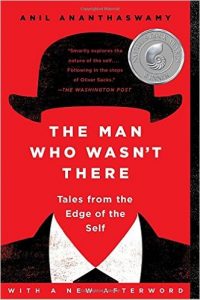I’ve commented before on my inexplicable interest in books about mental health and mental illnesses. So when I was contacted by the publisher and asked if I would be interested in taking a look at the paperback release of journalist and former New Scientist deputy editor  Anil Ananthaswamy’s exploration into the nature of the self through a series of interviews with sufferers of complex and in many cases exceedingly unusual neuropsychological conditions, I was immediately intrigued. My review copy was generously provided by Penguin Random House, via NetGalley.
Anil Ananthaswamy’s exploration into the nature of the self through a series of interviews with sufferers of complex and in many cases exceedingly unusual neuropsychological conditions, I was immediately intrigued. My review copy was generously provided by Penguin Random House, via NetGalley.
The book is presented as a series of vignettes exploring a variety of conditions ranging from the all-too-common (like Alzheimer’s Disease, schizophrenia and autism) to the relatively unusual (body integrity identity disorder (BIID), ecstatic seizures, and doppelgangers). The vignette chapters include interviews with individuals and families dealing with these conditions, as well as scientific and philosophical analyses of the implications of the conditions on the nature and realization of the self. The concept was highly intriguing to me. As I’ve mentioned before, I was a philosophy major; I find discussions of the nature of mind/body and mind/brain duality fascinating. Layered on top of my interest in the various ways that our brains can break down – and let us down – I was really curious to see where Ananthaswamy would take his analyses.
While I found the individual stories exactly as fascinating as I anticipated, I was a bit put off by the philosophy and science – which disappointed me quite a bit. Even I, with a background and training in reading philosophical theory layered on top of a legal career in pharmaceutical regulatory and research and development work (which gave me more than passing exposure to many of the more common conditions presented in the book), found a lot of the analytical discussion overly dense and difficult. I found myself reading and rereading, and still not entirely sure where he was trying to go… I found myself skimming over those paragraphs in the later chapters; the text therein occasionally felt rehashed in ways that didn’t really add any new insights or, alternately, felt like an overly technical exegesis for the otherwise easy-going style of the personal narratives. Frankly, I expected a smoother transition from someone with the author’s background.
Still, there is a lot of food for thought here – even if I found it a more difficult meal than I expected. The suffering of these individuals and their families came across clearly and sympathetically, without any melodramatic tugs on the heartstrings. There wasn’t any need for that – the difficulties faced by those suffering from these conditions (both the individuals themselves and their caregivers and loved ones) were heart-breaking enough without any extra bells and whistles. I’ve always thought that the worst possible suffering must come from feeling trapped inside your own head – after reading this collection, I’ve amended that to feeling trapped inside your own head OR body. Attention to the conditions enumerated in this book can only help advance the search for ways to help un-trap those who suffer, and that is a worthwhile endeavor indeed…


 Jill-Elizabeth LinkedIn
Jill-Elizabeth LinkedIn



Leave a Reply